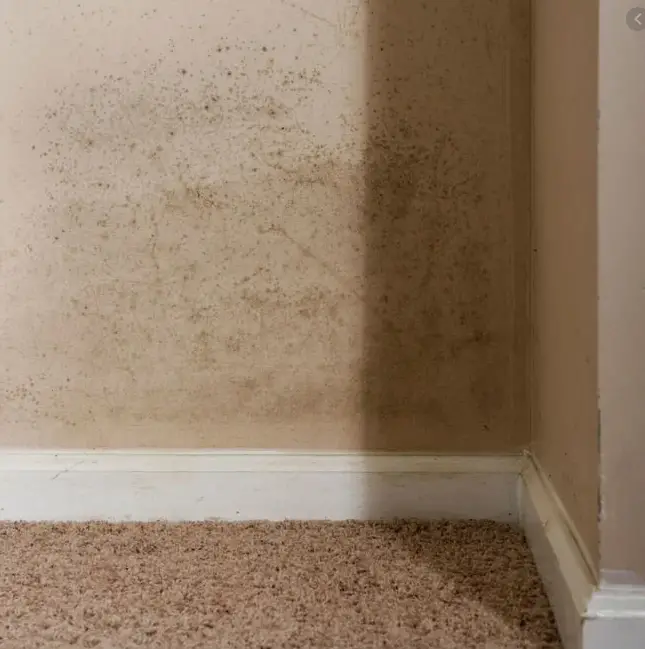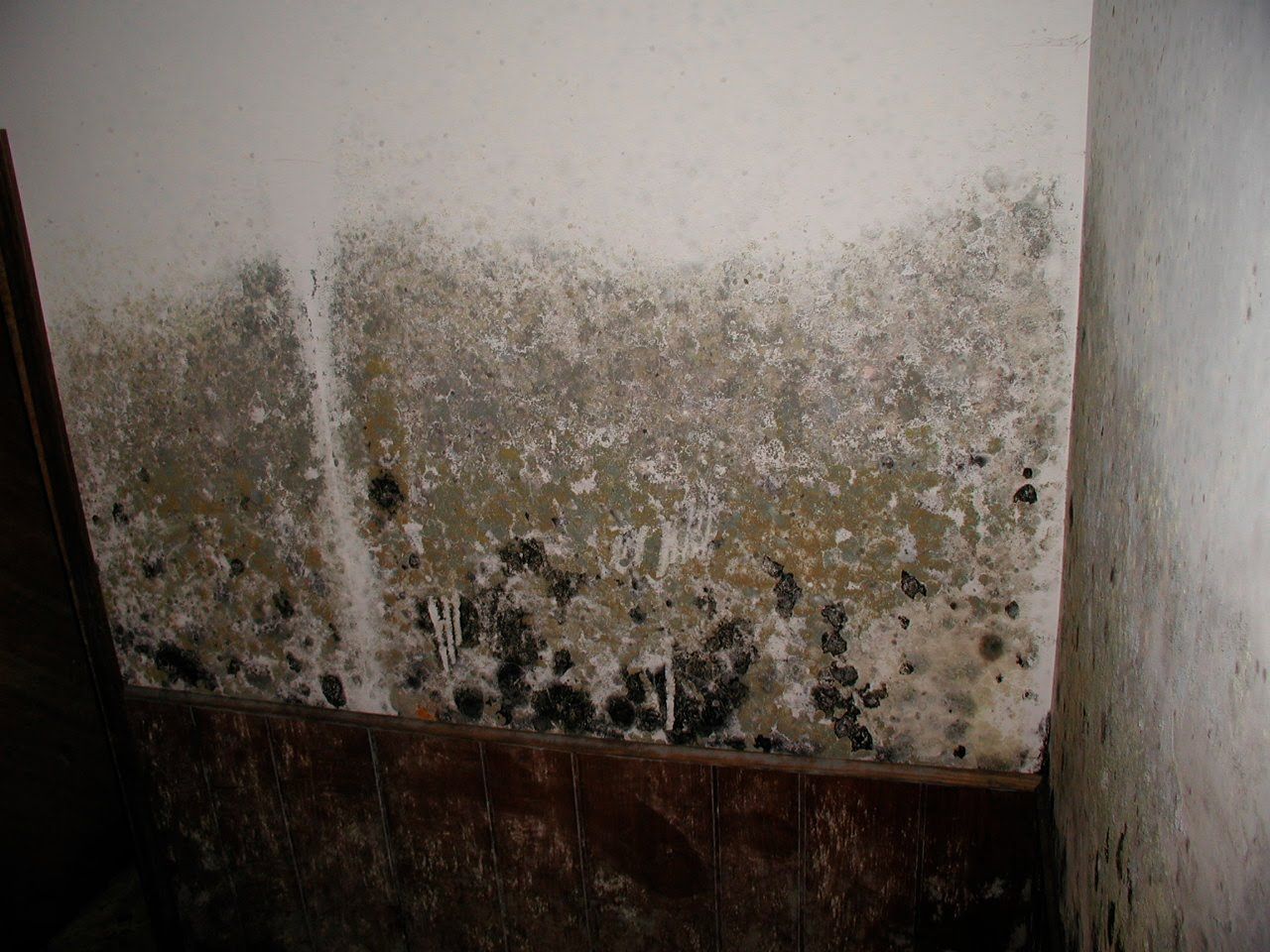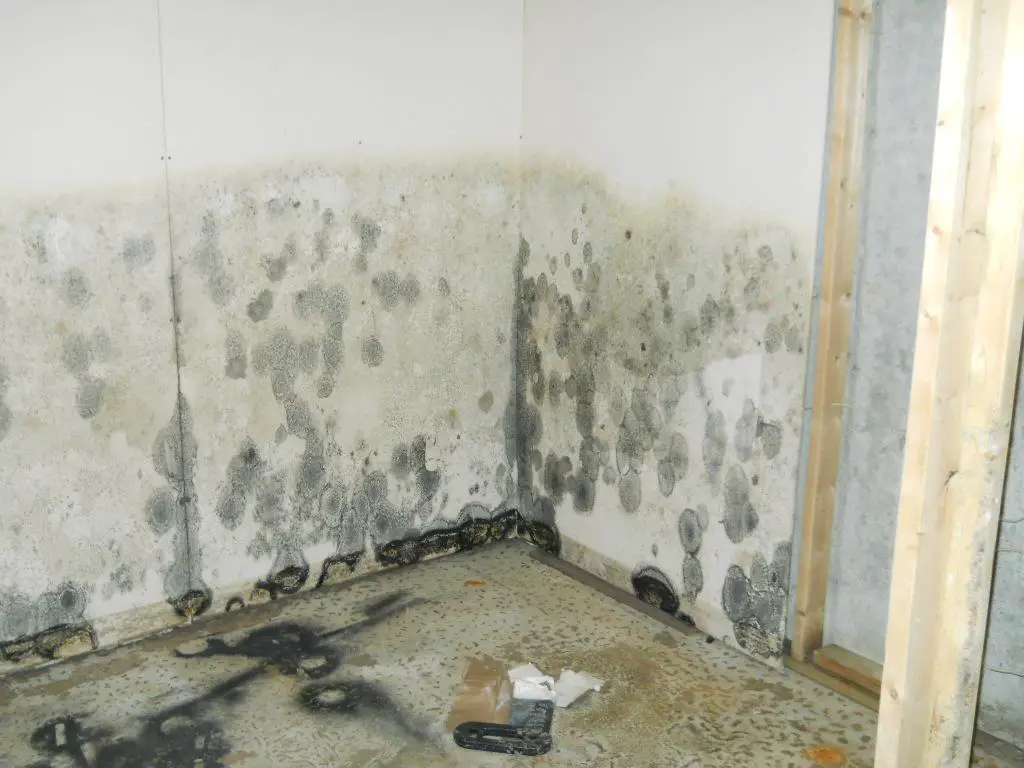Keep The Humidity Low
A humid environment can encourage mold regrowth in the future. Do your best to keep the space dry and mold-free by minimizing the humidity levels. Use a dehumidifier to keep the humidity between 30 and 50 percent to deter mold from growing in other areas.
Following these steps will help you remove mold from your drywall surfaces and discourage it from growing back.
Black Mold Loves Growing On Drywall Because It Is Basically A Giant Food Source
Made up of gypsum encased in two layers of soft paper, black mold feeds on the paper as a food source.
Drywall also soaks up water like a sponge, stays wet for long periods of time, and is difficult to properly dry. When drywall gets wet, mold usually grows on both sides of the drywall the side you can see, and the backside thats behind the wall that you cant see.
Simply cleaning the mold off of the side you can see is not enough. Youve got to get to both sides of the drywall.
Outside of a surface mold from humidity scenario, the best strategy for removing black mold from drywall is simply to cut out the impacted drywall and replace it with new. Dont waste your time trying to clean it. Its best to cut it out, bag it up, and throw it away.
If youre thinking of removing mold from drywalls yourself, here are a few steps. A more in-depth guide can be found in our eBook!
If youve got paneling instead of drywall, its best to take down the entire section of paneling rather than cutting it. Usually taking it down involves prying it off the wall.
Black Mold On Drywall In Basement
Basements are one of the most common areas to find mold in a home. Due to the lack of ventilation and humidity, many people develop moisture in their basements that make it the prime breeding ground for all sorts of mold and bacteria.
Black mold is made of a toxic microfungus that can cause a host of health complications in humans. The sticky black spores of Stachybotrys chartarum are ingested or inhaled, leading to chronic respiratory problems and even the development of internal bleeding.
Basement drywall mold isnt just hazardous it also spreads fast. Removing the mold as and any traces of bacteria from your home as soon as possible is vital for protecting your property and health.
You May Like: How To Detect Mold In Your Body
Gather Your Drywall Mold Removal Equipment
When you remove mold, youll undoubtedly stir up spores and send them airborne. Wearing long sleeves and pants, as well as rubber gloves, a respirator mask, and a pair of safety glasses will help keep those spores from irritating you.
Related
4 Types of Whole House Air Filters
To help minimize the number of spores in the air, use a vacuum fitted with a HEPA filter to remove surface spores. Its also a good idea to block the rest of the home off with plastic sheeting and run a negative-pressure HEPA air filtration system, which you can rent from most tool rental shops.
Other materials youll need:
Looking For Mold In Walls

If you have mold on drywall, there is a possibility there can also be mold inside the walls, including in the insulation and on wooden studs within the walls. While you’re removing and replacing drywall, make sure you look carefully for signs of mold inside the walls. Here is more about mold in walls.
Don’t Miss: How To Mitigate Black Mold
How To Remove Mold On Any Type Of Drywall
Mold discovered on the interior walls of a rental is an environmental hazard that can cause concern among tenants. Not only does it look unpleasant, but exposure to toxic mold is a health hazard that could cause health problems such as respiratory issues, rashes and chronic fatigue.
As a landlord, you can be held liable for any issues caused by mold in your building. Tenants have won multi-million dollar cases against landlords for significant health problems caused by exposure to toxic mold in their rentals, so its best to take care of the problem not only for the health of your tenants, but for your wallet.
If you suspect mold in your rental, learn what to look for and how to safely remove mold on drywall so you can avoid any rental complaints and ensure a safe and healthy living space for your tenants.
What Does Black Mold Look Like
The appearance of black mold can vary depending on the species, but it is usually a black to dark brown or greenish-black slimy film that grows on organic matter. It is often found in damp and dark places such as basements, bathrooms, and crawlspaces. Its easy to confuse black mold with other types of mold that you might encounter in your home.
Here are some signs that indicate youve got black mold:
- Unpleasant odors coming from your walls or other surfaces
- Moldy patches on walls or ceilings
- Mold growth on woodwork or other building materials
- Musty smells in different rooms of your house
You May Like: How Remove Mold From Shower
Use A Bleach/water Combination
Using a mixture of 0.5 cup bleach to 1 quart water, take a scrub brush and lightly brush the drywall until all of the signs of mold disappear.
Youll want to wipe off the surface once it has disappeared, but make sure you dont rinse the surface. By leaving the bleach on, youll be able to kill the spores which may be in the drywall.
Expose the drywall to sunlight if at all possible.
Diy Mold Removal Options For Drywall And Wood
As you can see, removing black mold on drywall and wood is not very difficult. It basically requires some elbow grease and a mold stain remover cleaning agent.
Check out our DIY mold removal eBook for more detailed steps on how to be successful with this. This link also contains some important safety information and equipment you will want to use if you decide to remove it yourself!
If youre not comfortable doing it yourself, and you live near one of our locations in Chicago or St. Louis, you can contact us to get it done. Either way, removing black mold on drywall and wood is nothing to be afraid of.
Recommended Reading: How Do You Get Mold Smell Out Of Wood
The Tea Tree Oil Solution
Tea tree oil can be used to not only keep spiders away but also to eradicate black mold naturally. The natural fungicide doubles as cleaning product with the strength to prevent those ugly mold spores from coming back.
To use it, combine 1 teaspoon of tea tree oil to 1 cup of water and increase the quantity ratio from there. Shake it up and pour it into a spray bottle so you can maximize coverage. Once applied to the moldy area, leave it to dry for an hour, and then wipe away the oil with a microfiber cloth or dry towel. Before you start this process, be sure to to put on protective gloves even though the tea tree oil is a natural solution, it can still irritate your skin.
Black Mold On Top Of The Drywall Paint
If the mold is on top of the paint, removal is simple.
- Step 1: While wearing gloves and a respirator to protect you from spores, use plastic to cover the floor.
- Step 2: Make a cleaning solution with half a cup of bleach to one gallon of water.
- Step 3: Apply this solution to the mildew and let it sit for at least fifteen minutes.
- Step 4: Next, wash the area with a small amount of dishwashing liquid and clean water, then rinse with water and dry completely. All signs of the mold should be gone.
Also Check: Can You Paint Over Mold On Wood
Water And Bleach Method
If your mold is still in its early stages, then you can mix half a cup of bleach with a quart of water to make a mold-killing agent. Mix it together well and then brush it onto the mold areas of the drywall until the mold goes away. When you are finished, wipe down the surface to remove any excess moisture. Dont rinse the areas. Leaving the bleach on the drywall will help kill other spores that are hiding in the material.
How To Remove Mold On Painted Drywall

If you find mold on drywall that is painted, its much easier to clean. Since paint provides a barrier on the drywall, the mold most likely hasnt penetrated the surface, meaning you just need a good cleaner and some elbow grease.
Before you start, make sure you identify the source of moisture causing the mold in the first place and fix the issue. Then, follow these steps to remove mold on painted drywall.
Also Check: What Does Mold Feel Like
Final Word On Black Mold: Best Avoidedbut Not Deadly
As for black molds toxic reputation, those with immune suppression, asthma, or other respiratory problems are most at risk of feeling ill.
Its not likely that youll die from black mold poisoning because its just not that toxic. That said, you should act quickly if you find it in your home. The good news is its treatable, removable, and preventable.
Why Is Mold Such A Problem
Firstly, why is mold on drywall seen as such a problem?
Don’t Miss: Does Mold Make You Itch
Clean Walls Clean Home
If you notice signs of mold growth on the walls of your home, youll need to take action before it spreads. It can potentially cause health and structural problems to your property.
The most important thing to do is fix the problems source to prevent mold growth. Then, depending on the size of the affected area, you can either clean the mold yourself or hire a professional.
Removing small patches of mold yourself is relatively easy. You can use readily available products such as borax, vinegar, baking soda, tea tree oil, bleach, and hydrogen peroxide. But, if mold covers a substantial area of a wall, you should seek expert help immediately.
Removing Mold On Drywall Surfaces For Good
In the unfortunate event that you have a mold growth problem on your drywall, there are five methods for cleaning and killing it. The severity of growth will determine which one is best suited to use in order to effectively remove the mold.
Dont forget to wear safety equipment including goggles & gloves! After completing clean up ventilate well because this is the time mold spores are released into the air.
Also Check: Is Black Mold Easy To Remove
How To Remove Mold From Walls
Mold on your interior walls doesnt just look unpleasant it can be a health hazard for your family. Depending on the amount and location, its presence also suggests a larger problem in your housewater infiltration.
For this project, we will focus on solving the mold problem. The remedy is two-fold: 1. Control moisture and 2. Kill the mold. While the former may take a more involved approach, depending on the situation, the latter often can be done with some bleach, water and a bit of elbow grease.
Is Black Mold That Dangerous
The first reason you want to remove drywall that has started to grow black spots on it is because its unsightly. Its nearly impossible to completely clean the black mold spots off of drywall, so even after the wall has been repainted those black spots will start to eventually creep through. Its even worse if you dont see them though, as that means mold is growing behind the wall.
Of course the main objective of disposing drywall with black mold is to preserve the health and integrity of a homes air circulation. Young people, those with allergies, and individuals with respiratory illnesses such as asthma will be especially affected by the presence of black mold, or stachybotrys chartarum. They will experience wheezing, a runny nose, irritated eyes, and just an overall unpleasant time.
So if you dont have allergies or respiratory problems can the mold be left as is? The quick and simple answer to that is, no. Mold doesnt just simply go away and in fact it does the opposite and grows. Your few spots of mold might not be a problem now, but they most certainly will be someday.
Plus, even if a homeowner doesnt experience an adverse reaction to the mold, it still smells. That odor only increases over time, which does nothing to boost the market value of your property.
Also Check: What Does Black Mold Do
How To Get Rid Of Mold On Walls
Many people first notice theyve got a mold problem when they see it growing on their walls. Check in the corners near the ceiling and floors in rooms with high moisture levels, such as kitchens, bathrooms, laundry rooms, and basements.
Youll need:
Scrubbing brush
Method:
Step 1: Make a solution of one part bleach to three parts water in the spray bottle.
Step 2: Saturate the mold and surrounding area on the wall.
Step 3: Let the solution soak into the mold for 10-15 minutes.
Step 4: Using the scrubbing brush, remove the mold and stains.
Step 5: Repeat as necessary to remove all the traces of mold and mildew.
Step 6: Make a 50/50 mixture of white vinegar and hydrogen peroxide in the second spray bottle.
Step 7: Spray the cleaned surface and allow it to absorb and air dry.
This method works because it addresses the visible mold, as well as the underlying roots that often go untreated. Surprisingly, vinegar and hydrogen peroxide are both more effective at killing mold roots than bleach. Because they work best on different types of mold, try to use them together to cover all the possible varieties of mold you might be dealing with.
Pro Tip: If you dont have hydrogen peroxide at hand, you can also clean mold with vinegar and baking soda instead.
Use Borax To Scrub Away The Mold

Borax has a higher pH than baking soda or vinegar, which makes it the best option for killing mold. Youll want to use 1 cup of Borax for every gallon of water you use.
Take a vacuum and remove as much freestanding mold as you can.
Then scrub the mold with your Borax solution until the signs of it disappear from the drywall. Wipe away any excess moisture and allow the drywall to then dry.
Dont rinse off the mixture.
Vinegar is an even safer option, but it only kills about 80% of household molds that may form.
It may be non-toxic, but it may also be ineffective.
If you do use vinegar or baking soda, make sure you leave your preferred cleaner on the mold for several minutes before scrubbing it away to achieve best results.
Youll then want to apply vinegar on the affected drywall every few days for a couple months to make sure no spores decide they want to grow.
Read Also: How Do You Get Rid Of Mold In Your Body
Is It Mold Or Mildew
Mold and mildew are fungi that thrive in humid conditions with poor ventilation. The most common causes of mold and mildew on walls are condensation, humidity, and water leaks.
Mildew is gray or white with a powdery texture. You can find it lying on flat surfaces in moist areas. As mildew is a surface mold, it wont damage your propertys structure .
Mold is a fungus that spreads from airborne spores. It is usually black, yellow, or green and has a fuzzy or slimy texture. Mold can cause structural issues in your home, as well as health issues.
How To Kill Mold On Drywall
As Winter turns into Spring, many homeowners find themselves with an unpleasant surprise lurking on the drywall around their windows: mold.
Mold can also form in any environment which sees a consistent moisture level.Bathrooms can be mold incubators all year long.
Because you have a much higher risk of developing airway inflammation and infections when mold is present, youll want to know how to kill mold on drywall.
The good news is that if you kill the mold right away, you can usually save the drywall.
If the mold has been lingering there for awhile, you might need to replace the contaminated section.
Your best option is to be proactive and create less of a moisture-rich environment by keeping condensation to a minimum and running dehumidifiers in bathrooms or other high risk environments.
If the mold is already there, then you can kill it with these useful options.
Recommended Reading: How To Remove Toxic Mold From Your Body
